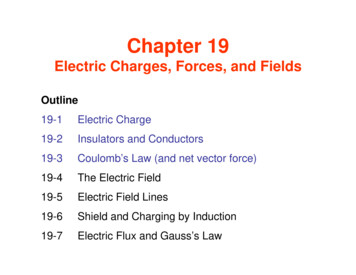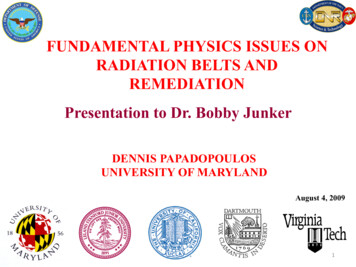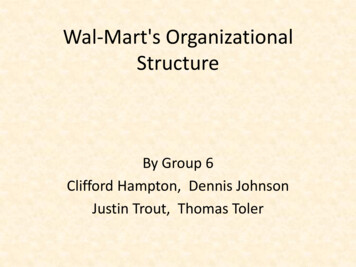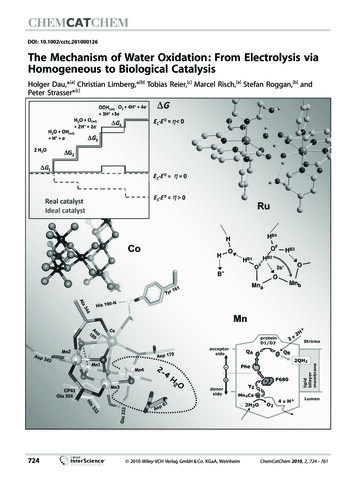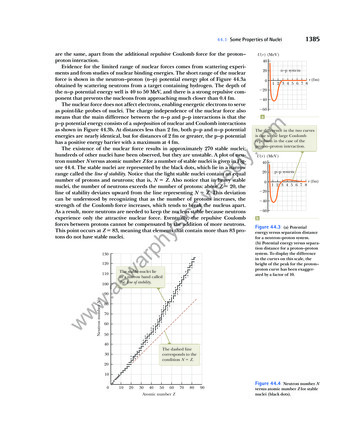
Transcription
The Structure of the Proton and HERAMax KleinUniversity of Liverpool, Physics Department, Oxford Street, L69 7ZE Liverpool, UKDOI: http://dx.doi.org/10.3204/DESY-PROC-2009-03/KleinA brief summary is given on what we have learnt from inclusive DIS measurements withHERA on the structure of the proton, recalling some experimental results available twentyyears ago, and presenting some HERA milestones up to most recent results.1IntroductionThis paper summarises a seminar given at the PHOTON09 conference. It therefore is not atypical conference contribution. The seminar title was “What have we learned on proton structure from HERA?” devoted to the collider experiments H1 and ZEUS. This subject is difficultto discuss on a few proceedings pages. Before HERA, and following the seminal discovery ofpointlike constitutents of the proton at SLAC, now 40 years ago, a series of neutrino and muondeep inelastic scattering (DIS) experiments was performed in order to study the partonic structure of nucleons further and to also develop and test Quantum Chromodynamics (QCD), whichhad been put forward as the gauge field theory of the strong interaction of confined quarksand gluons. Some of the findings of these fixed target experiments are recalled here in order tounderstand better the new developments which HERA brought. The kinematic range of theseexperiments was determined by the cms energy squared, s 2Mp El , i.e. by the lepton beamenergy El , typically 200 GeV, and the mass of the proton Mp as the fixed target energy.HERA collided electrons (and positrons) of 27.5 GeV energy with protons of 820/920 GeVenergy. There were three main reasons for HERA to provide a much deeper understanding ofproton’s structure than the fixed target experiments of the eighties: i) The energy s was muchincreased with the now moving proton “target”, to values of s 4Ee Ep ' 105 GeV2 , more thantwo orders of magnitude higher than before; ii) At the collider, the scattering kinematics isdetermined from the scattered electron angle and energy, from the hadronic final state or/andfrom a combination of the electron and hadron momenta. The redundancy of the kinematicswas at the origin of the reliability and large kinematic range of the HERA measurements; iii)The two collider experiments H1 and ZEUS had a nearly 4π acceptance which enabled theradiative corrections to be much suppressed by establishing the energy-momentum balance ofeach event.In this very brief summary a few developments may be recalled only, and the discussion isrestricted to inclusive scattering. A detailed overview on experimentation at HERA and theresults achieved with the data taken until 2000, in period I, can be found in these proceedingsand in [1]. The slides of this talk are available from the PHOTON09 web site.Section 2 presents a reminder on experimental results on DIS available before HERA. Section3 recalls the first two major observations, made by H1 and ZEUS, the rise of the proton structurePHOTON09PHOTON091431
M AX K LEINfunction F2 (x, Q2 ) towards low x and the existence of a significant fraction of events, in whichthe proton remained intact, a process then termed deep inelastic diffractive scattering. It alsoreminds of ideas, discussed in 1994, on the increase of the luminosity and future measurements,in particular of the longitudinal structure function FL , which eventually was pursued prior tothe termination of HERA’s operation in 2007. Section 4 presents most recent results whichhave allowed completing the analysis of the HERA I data, a combination of H1 and ZEUSmeasurements and a joint QCD analysis. Section 5 presents some recent preliminary results,based on the full HERA statistics, completion of which will end the analysis of the inclusivecross section data in the not far future. A short summary is presented in Section 6.2Experiments before HERATwenty years ago, seven major experiments on deep inelastic scattering (DIS) were analysingdata, the BCDMS, BFP and EMC muon experiments and the BEBC, CCFRR, CDHSW andCHARM neutrino experiments. These experiments measured neutral (NC) and charged current(CC) scattering, respectively, at values of momentum transfer squared Q2 up to some 100 GeV2and Bjorken x values above 0.01, as is summarised in [2].The inclusive DIS cross section, at lower Q2 , is determined by the two proton structurefunctions F2 and FL asMp2 x2 2d2 σ2πα22πα2y2 [(Y y )F2 y 2 · FL ] ' 4 Y [F2 FL ], 242dxdQQ xQQ xY (1)where y Q2 /sx is the inelasticity of the process, or the relative energy transfer in the fixedtarget configuration, and Y 1 (1 y)2 . The structure function expression F2 y 2 /Y ·FL isreferred to as the reduced DIS cross section σr . In the Quark Parton Model (QPM) for photonexchange, F2 is determined by the sumPof quark and anti-quark distributions weighted by theelectric quark charges squared F2 x e2q (q q), and FL 0.Figure 1 shows one of the salient measurements of that time, the structure function F2 (x, Q2 ),for different x between 0.07 and 0.75 as a function of Q2 , from 9 to 220 GeV2 , as obtained bythe BCDMS Collaboration in µp scattering [3]. This data set, a combination of data from fourdifferent muon beam settings, has been crucial input for most of the subsequent extractions ofparton density functions (pdf) until today. With an accuracy of up to about 2%, the data arerather precise, with good coverage of the large x region. The plot illustrates that the BCDMSdata continue the behaviour of the historic SLAC ep data, obtained at lower Q2 , albeit sometrend is visible of F2 being a bit flatter at larger x in the BCDMS measurement. The tendencyof the BCDMS data to be ‘flat’ leads to a rather small value of the strong coupling constant α s ,of about 0.11 at Q2 MZ2 when using the BCDMS data alone. There is also a clear deviationvisible of the EMC data from the BCDMS result, in particular at lower x (left part of the plot).It was realised subsequently that the EMC analysis was incomplete at low x, and the BCDMSresult was supported by the CDHSW data. The BCDMS Collaboration had also deuteron datataken, as did many other DIS fixed target experiments, unlike HERA, which was not given thetime to study the structure of the neutron in the much extended range.Using the variation of the muon beam energy, the BCDMS collaboration determined theratio of the cross sections of longitudinally and transversely polarised virtual photon-protoninteractions, R σL /σT FL /[(1 Mp2 x2 /Q2 )F2 FL ] ' FL /[F2 FL ]. The result, as shownin Figure 2, covers an x range from about 0.1 to 0.65 with a tendency to larger R values of2432PHOTON09PHOTON09
T HE S TRUCTURE OF THE P ROTON AND HERAFigure 1: Solid points: Combined measurement of F2 by BCDMS at low x (left) and large x(right). Open points: Corresponding data from EMC. Squares at lower Q2 : F2 measured in epscattering at SLAC.about 0.15 towards smaller x values. Since FL is sensitive to the gluon distribution xg [4], anincrease of R may be caused by an enlarged xg. The information on xg available from thefixed target DIS experiments had yet been sparse. The gluon distribution cannot be measureddirectly but is deduced from QCD analyses. Since it does not enter the non-singlet evolutionequations, obeyed by the valence quarks which dominate at high x, it is difficult to extract xgaccurately from large x DIS data alone. An attempt to determine xg was performed by theBCDMS Collaboration [5]. Using the momentum sum rule and fixing αs , the result of Figure 2was obtained for a few x bins around x 0.1. The solid overall curve describes the NLO QCDfit result [5] giving xg 4.93(1 x)8.3 at Q2 5 GeV2 .A series of DIS neutrino and anti-neutrino scattering experiments provided complementaryinformation to the muon experiments. These experiments, by the nature of the W exchange,are sensitive to the flavour decomposition of proton structure. An example is given in Figure 3,which shows the simultaneous measurement by CDHSW [6] of the sum of the anti-quark distributions and of FL , expressed as R, in the range of x between 0.015 and 0.65 and of Q2 fromabout 0.5 to 200 GeV2 . This decomposition relies on the different y dependence, at large y, ofthe anti-neutrino and neutrino-nucleon scattering cross section difference on q and FL 2 νN1 d2 σ νN2d σ [1 (1 y)4 ]q ν [(1 y) (1 y)3 ]FL .(2) (1 y)σ0 dxdydxdyThe result on R is very similar to the one from BCDMS. One also notices the result from theelectron scattering experiment at SLAC and the strong Q2 dependence of R at fixed, large xas shown in Figure 3. The result on the anti-quark distribution exhibits strong positive scalingPHOTON09PHOTON093433
M AX K LEINFigure 2: Measurements of R ' FL /(F2 FL ) by the muon DIS experiments BCDMS and EMC(left). Determination of the gluon distribution in NLO QCD by BCDMS (points and solid line)compared with LO determinations by BCDMS and EMC, at Q20 5 GeV2 (right).violations at small x, down to 0.01. From the νN and νN cross sections it was also possible todisentangle the x behaviour of the sum of quark and anti-quark distributions, q q, and theirdifference, which in the QPM was assumed to be equal to the valence quarks q q u v dv .As Figure 3 illustrates, it was found that above x ' 0.3 the proton structure was dominated byvalence quarks. QCD analyses showed that at low x the gluon distribution was exceeding thequark distributions.The determination of parton distributions twenty years ago had already reached a certainstate of art [7, 8]. Based on the Buras-Gaemers type of parameterisation [9], xP x λ (1 x)c , fitswere performed up to next to leading order (NLO), using global data sets, including systematicerrors and renormalisation scheme effects. The predictions for HERA were of wide range, asis illustrated in Figure 4. The low x behaviour was determined by the parameter λ whichwas predicted to change rapidly with Q2 . The value of λ was not fixed. In an alternativeapproach [10], parton distributions were radiatively generated, assuming that at a very smallinitial scale Q20 0.3 GeV2 both xg and q are zero and the renormalisation group equationwould still hold. This allowed predictions to be made for the behaviour of F2 in the so farunexplored range of very small Bjorken x, down to 10 4 . Results from HERA were eagerlyawaited.3First ResultsThe first years at HERA were particularly exciting and lead to a very large number of firstobservations and non-observations, as of lepto-quarks, which are reviewed in [1]. For the subjectof proton structure two observations were probably of key importance, the rise of F 2 at low x4434PHOTON09PHOTON09
T HE S TRUCTURE OF THE P ROTON AND HERAFigure 3: Right: Measurement of the total anti-quark distribution as a function of Q 2 for different x by CDHS. Left bottom: Measurement of R derived from the y distribution, comparedwith SLAC data at different Q2 (open points). Left top: Determination of the sum and differences of the the total quark and total anti-quark distributions and also of the gluon distributionas a function of x, at Q2 20 GeV2 .and diffractive DIS.The first measurements of the proton structure function F2 , shown in Figure 5, were basedon only 0.03 pb 1 of data, taken in 1992. With these first measurements the rise of F2 towardslow x was discovered. This rise is in agreement with general expectations on the low x (largeω 1/x) asymptotic limit of QCD [11]; however, the actual scale (Q2 ), at which the limit wouldbe applicable, was not predicted. The dynamical parton model approach, termed GRV91 inFigure 5, was rather successful.A second surprise came when an excess was observed of events with a much reduced activityin forward direction, usually populated by the remnants of the proton being in colour connectionwith the struck quark fragments. In 1993 an about 10% fraction of events was observed, seeFigure 6, in which apparently the proton yet stayed intact. The interpretation is that of adiffractive exchange, often termed the Pomeron, which carries a fraction xIP of the protonmomentum. A parton of momentum fraction β xIP /x interacts with the exchanged photonof virtual mass squared Q2 . The salient feature of these events is the absence of forward particleproduction, near the proton beam pipe, which is measured as an activity gap in polar angle,or equivalently rapidity, from the proton beam axis to the more centrally produced particleswhich stem from the struck parton in the diffractive exchange. Factorising out the Pomeronflux, the hard γIP scattering part can be treated as in conventional DIS. This allowed QCDPHOTON09PHOTON095435
M AX K LEINFigure 4: Extrapolation of the behaviour of F2 and the gluon distribution xg towards low xat Q2 10 (top) and Q2 104 GeV2 (bottom) within the framework of the 1991 global pdfanalysis [7]. The low x behaviour was phenomenologically determined by the term xB , whichcould be large or small. Both fits described the data which extended down to x about 0.01 ata few GeV2 . From the measurements of HERA one now knows that F2 at Q2 10 GeV2 andx 10 4 is about 1.7 and xg ' 13, thus somewhat closer to the B1 curves.analyses to be performed in order to derive the quark and gluon distributions of the diffractiveexchange. Such analyses are based on the diffractive cross section σ D(3)2πα2y 2 D(3)d3 σ ep eXYD(3) ·Y·[F F], 2dxIP dxdQ2xQ4Y L(3)which is integrated over the ranges of four-momentum transfer from the incoming to the outgoing proton and the dissociation mass. Similarly to inclusive DIS, the reduced ep cross sectionD(3)D(3)depends on the diffractive structure functions F2and FL . For y not too close to unity,D(3)D(3) F2holds to very good approximation. The field of diffractive DIS has developedσrvery much as the comparison of the first observations with a recent measurement of σ D(3) illustrates, Figure 6. The major result of detailed QCD analyses has been that the diffractiveinteraction dynamics, or the partonic contents of the diffractive exchange, for all β below about0.3, is dominantly due to gluons, in line with the view of the Pomeron representing a colourlessexchange of two gluons.In September 1994 a first meeting was held between the collider experiments and the HERAmachine experts in order to discuss the future. The luminosity development until then wassteady, as is illustrated in Figure 7, but the expectations had been on about 100 pb 1 annuallywhile by then only about 5 pb 1 had been collected. It was obvious that for the physics at highQ2 a much higher integrated luminosity was required. The machine was achieving an annual6436PHOTON09PHOTON09
T HE S TRUCTURE OF THE P ROTON AND HERAFigure 5: The first measurements of H1 (solid points) and ZEUS (open points) of the protonstructure function F2 (x, Q2 ) based on the data taken in 1992 shown as a function of Bjorken x.The HERA experiments were able to extend the kinematic range of the F2 data provided bythe fixed target electron (SLAC) and muon (BCDMS, NMC) proton experiments by two ordersof magnitude into the then-unknown domain of low x. For GRV91 see text.luminosity close to the expectations by summer 2000 when phase I was terminated and a majorupgrade began, in particular of the interaction regions. The result of placing focussing magnetsclose to the vertex was an increase of the specific luminosity by a factor of 4 which lead to alarge increase of the luminosity when HERA had overcome initial problems due to synchrotronradiation initiated background.At the 1994 meeting a further ‘first result’ was discussed. Besides a measurement of thestructure functions F2 and F2D there was an obvious interest in the measurement of the longitudinal structure functions, FL and FLD , because these would allow a non-trivial test of QCDat higher orders and provide independent information on the gluon density at low x. Figure 8presents the expectation on the measurement of R and the recently released, still preliminary,measurement of FL . The result is interesting: at Q2 lower than about 10 GeV2 , a region accessed with the upgraded backward apparatus of H1, the data tend to exceed the NLO QCDfit prediction which essentially is derived from the ln Q2 derivative of F2 . The definition ofFL to NLO and the exact treatment of the charm contribution near threshold are theoreticalissues under discussion. The data analysis is being finalised to accomplish publication of thisfirst observation [12], relying on the last data taken at HERA. Further interesting results on F Lhave also been obtained by ZEUS [13] while H1 has also measured FLD for the first time [14].4Precision ResultsSince the first results on F2 in the DIS region of Q2 of O(10) GeV2 , obtained with the initial data,the accuracy of this measurement was constantly improved. The most accurate measurementPHOTON09PHOTON097437
,-%&" '%(.*-))%!"# %&" '%()* ()%M AX K LEINFigure 6: Left: The first observations of hard diffraction - top left: Distribution in DIS eventsof ηmax , the maximum pseudorapidity of a cluster of energy larger than 400 MeV, in the ZEUScalorimeters; bottom left: Similar observation in the H1 DIS ηmax distribution compared witha simulation which included diffractive and genuine DIS events. Right: An example for arecent measurement of the diffractive DIS cross section as a function of Q2 for different β atxIP 0.01. The data are well described by a theoretical model based on QCD evolution ofdiffractive parton densities using a Regge factorisation ansatz.of F2 at HERA is shown in Figure 9 and may be compared for curiosity with Figure 5. Basedon H1 detector upgrades in the mid nineties, a huge step of improvement could be realised [15]and F2 is now known to nearly 1 % accuracy. The structure function rises approximately as x λtowards low x. There is no sign of saturation of this behaviour at lowest x in the DIS regionobserved. Using the 1997 H1 data the power was determined [16] as λ 0.05 ln(Q 2 /0.32 ) withQ2 in GeV2 . Together with a variety of measurements on neutral (NC) and charged current(CC) scattering by H1 and ZEUS, a first inclusive cross section combination was recentlypublished [17] of all HERA I data, which covers the wide kinematic range of 6 · 10 7 x 0.65and 0.045 Q2 30000 GeV2 . Due to the independence of the H1 and ZEUS results and theuse of complementary methods of kinematic reconstruction, the accuracy of the combined dataset is better than that of a simple mean.The combined data set was used for an updated QCD analysis at NLO [17] following theapproach introduced in [15] by H1, regarding in particular the parameterisation of the partondistributions and the treatment of uncertainties. As compared to the QCD fits prior to HERA,mentioned above, quite some substantial improvements to the art of extracting parton information from DIS cross sections have been introduced over the years. These rely on experimentalprogress as summarised in [1] and theoretical developments, especially the challenging calculations of QCD to higher orders which reached the NNLO level [18]. These improvements are: i)a refined treatment of experimental uncertainties in terms of their uncorrelated and correlatederror contributions; ii) a choice of parameters based on χ2 saturation criteria supplemented8438PHOTON09PHOTON09
T HE S TRUCTURE OF THE P ROTON AND HERAFigure 7: Development of the integrated luminosity at HERA over time. Left: Status inSeptember 1994 as presented by Ferdinand Willeke at an upgrade meeting; right: The luminosity delivered by HERA in the first phase (1992-2000) and the upgrade phase (2003-2007).The last four months were devoted to the lower proton beam energy runs. The trend resembledHERA I as the luminosity is proportional to Ep 2 , i.e. the factor 3-4 loss due to the reductionof Ep at the end of HERA’s operation brought the luminosity back to HERA I values of about10 31 cm 2 s 1 .by in depth investigations of possible and inacceptable fit solutions; iii) attempts to considersuch parameterisation uncertainties in the final error bands; iv) following the measurements ofcharm and beauty densities by H1 and ZEUS and theoretical prescriptions, still developing, asimulation of the threshold effects of c and b density contributions; v) a consideration of theeffect of parameters such as cut or mass values. The results therefore are more reliable, notonly due to the improved experimental input. There remains an element of subjectivity in performing such analyses, which underlines the importance of having several approaches, some ofwhich are cited below [19]. There are yet some common observations associated to HERA datawhich may be illustrated well with the recent HERAPDF1.0 fitpresult [17] in Figure 10. Theapparent structure of the proton depends on the resolution 1/ Q2 , with which it is probed.At Q2 of about 1 GeV2 , corresponding to 0.2 fm, the proton structure may be decomposed asis shown in Figure 10 top. The gluon distribution has a valence like shape, i.e. at very low xthe momentum is carried by sea quarks. At medium x 0.05 the gluon dominates over allquarks. At largest x, above 0.3, the proton structure is dominated by the up and down valencequarks. This picture evolves such that below 10 16 m for x 0.1 the gluon density dominatesalso over the sea quark density, see Figure 10 c,d). One may compare this HERA result withthe early determination of xg by BCDMS, as shown in Figure 2, or the pdf determination byCDHS, Figure 3, to judge upon the immense progress achieved. The valence quarks are ratherinsensitive to the resolution, i.e. for any Q2 a rather constant behaviour of the valence quarksis observed which is a feature of their non-singlet transformation behaviour in QCD.PHOTON09PHOTON099439
M AX K LEINFigure 8: Left: Projected measurement of R FL /(F2 FL ) as presented to the upgrademeeting in September 1994. The plot indicates the need for an upgrade of the backward regionfor accessing the region below Q2 of about 10 GeV2 . Right: Measurement of FL with datataken 15 years later. In the low Q2 region the predictions from various fits differ most, and theH1PDF2009 calculation tends to be below the still preliminary data.5OutlookIn the second phase of beam operation, HERA II, a much increased integrated luminosity wastaken. For e p, a tenfold increase was achieved because in HERA I, due to lifetime limitationsfrom trapped dust particles, only 15 pb 1 could be registered. Figure 12 shows the so far mostaccurate data on the inclusive CC scattering1 , e p νX, provided by ZEUS. One sees thatthe striking characteristics of CC, the missing transverse momentum, is well understood. TheFigure also illustrates the confirmation of the linear dependence of the CC cross section on thelepton beam helicity. Unlike NC, the CC cross section is sensitive to the flavour contents of theproton. This is shown in Figure 12 with the decomposition of the cross section into the up quarkpart, u c, and the down quark part d s, weighted by (1 y)2 . At highest Q2 the data extendto x 0.65, albeit with limited accuracy. Currently the H1 experiment is completing a similaranalysis. It then is intended to combine the H1 and ZEUS HERA II measurements, which willimprove the accuracy obtained from the combination, illustrated in Figure 11, especially in thehigh Q2 domain.Deep inelastic scattering is the cleanest method to search for sub-substructure effects inthe proton. The results from HERA, based on the total data statistics, limit a possible quarksubstructure, within the most simple form factor approach, to a dimension below 6 · 10 19 m,which is about a factor of 100 below where quarks appeared and a factor of 1000 below theradius of the proton. This is deduced by both H1 and ZEUS from the Q2 behaviour of theinclusive NC cross section. This and a number of further results are being finalised by thecollaborations.1 A salient feature of HERA was that it measured simultaneously the NC and the CC scattering processes.Thus H1 and ZEUS were the equivalent, at much increased kinematic range, of both the charged lepton (e, µ)and the neutrino fixed target scattering experiments of the past. Loosely speaking, H1 for example was BCDMSand CDHS in one apparatus, and it also combined many physicists from these and similar experiments.10440PHOTON09PHOTON09
T HE S TRUCTURE OF THE P ROTON AND HERAH1 CollaborationF2Q2 12 -1-3-41010-210010Q2 45 GeV2-4-31010-210-110Q2 60 GeV21.51.51110.50.50.500-110Q2 120 GeV2-4-31010-210-4-31010.50.50-4-3-2-110 10 10 10-210-1-1Q2 150 GeV2 10-4 10-3 10-2 10-110-4 10-3 10-2 10-11.5110Q2 90 GeV21.50101.501-10.5Q2 25 GeV21.5Q2 35 GeV21Q2 20 GeV21.50101.50Q2 15 GeV21.510-4 10-3 10-2 10-1xH1PDF 2009H1 DataH1 Low Q2H1 High Q2xFigure 9: Recent precision measurement [15] of F2 based on the H1 data taken in 2000.6SummarySo, what has been learned with HERA on the proton structure? This is not easily summarised ina few statements because H1 and ZEUS found a new world of parton dynamics inside the proton.Major observations which were not known before are: i) there is no substructure of quarksdown to 6 · 10 19 m; ii) the gluon momentum distribution, for x . 0.1, dominates the protonstructure having evolved from very small values at low x and Q2 ' 1 GeV2 ; iii) QCD at higherorders is able to describe the dynamic change of partonic momentum distributions with linearevolution over more than four orders of magnitude in Q2 , with suitable parameterisations ofthe x dependence and question marks regarding the low Q2 , x domain as accessed with joint F2and FL measurements; iv) HERA discovered diffractive DIS at the level of 10 % of the inclusivecross section. There has also been made major progress in the understanding of the hadronicfinal state, in the formulation of parton amplitudes from deeply virtual Compton scattering, inthe measurement of the heavy quark contents of the proton including its theoretical description,and further areas of lepton-nucleon scattering not covered here.HERA has been a major and extremely successful milestone in the development of particlephysics. Ahead are still a large number of problems, some raised by HERA, to be solved for anunderstanding of nucleon’s structure. These, for example, are: i) why are leptons and quarksdifferent in the strong interactions; ii) is the gluon density saturating at low x, as unitarityrequires, and is it equally distributed over the proton or concentrated in so-called hot spots;iii) what is the exact momentum distribution of all quarks and anti-quarks in the proton,PHOTON09PHOTON0911441
H1 and ZEUS1H1 and ZEUSxfxfM AX K LEINQ2 1.9 GeV2HERAPDF1.00.8xSexp. uncert.model uncert.parametrization uncert.0.6Q2 1.9 GeV210xuv1xgxuvxdv10-10.4xdvHERAPDF1.0exp. uncert.10-20.2model uncert.xg ( 0.05)xS ( 0.05)parametrization uncert.-310-21010-1x1-310H1 and ZEUS1Q 10 GeV210-1xg10HERAPDF1.00.810-2x1H1 and ZEUS2xfxf10-410-3 -410Q2 10 GeV2xSexp. uncert.model uncert.parametrization uncert.0.61xuvxuvxg ( 0.05)xdv10-10.4xdvxS ( 0.05)HERAPDF1.0exp. uncert.10-20.2model uncert.parametrization ure 10: Parton distributions as determined by the QCD fit to the combined HERA I dataat Q2 1.9 GeV2 (top) and at Q2 10 GeV2 (bottom). The inner error bands show theexperimental uncertainty, the middle error bands include the theoretical model uncertaintiesof the fit assumptions, and the outer error band represents the total uncertainty including theparameterisation uncertainty. Here xS 2x(U D) denotes the total sea quark density.12442PHOTON09PHOTON09
T HE S TRUCTURE OF THE P ROTON AND HERA σr,NC(x,Q )H1 and ZEUS210 610 51042x 0.08 (x50.0)10x 0.13 (x20.0)x 0.18 (x8.0)x 0.032, i 71x 0.25 (x2.4)x 0.08, i 5x 0.13, i 4x 0.18, i 3110x 0.032 (x170.0)x 0.05 (x90.0)1010x 0.02 (x300.0)10 2x 0.05, i 610HERAPDF1.0 e pHERAPDF1.0 e-pHERA I NC e pHERA I NC e-p10 3x 0.005, i 11x 0.008, i 10x 0.013, i 9x 0.02, i 810 310HERA I NC e pFixed TargetHERAPDF1.0x 0.00005, i 21x 0.00008, i 20x 0.00013, i 19x 0.00020, i 18x 0.00032, i 17x 0.0005, i 16x 0.0008, i 15x 0.0013, i 14x 0.0020, i 13x 0.0032, i 122σr,NC(x,Q ) x 2iH1 and ZEUS10 710x 0.25, i 2-1-1x 0.40 (x0.7)x 0.40, i 1-210x 0.65, i 0x 0.65-2-31101021031041052Q / GeV21021031042105Q / GeV2Figure 11: Combined H1-ZEUS HERA I measurement of the reduced neutral current crosssection σr , which at lower Q2 and y is a direct measure of the proton structure function F2 .On the right side the e p and e p cross sections are shown as open and closed symbols. Thelines are from an NLO QCD fit to these data, from which at high Q2 charge asymmetry effectsare clearly visible which result from the charge dependent γZ interference cross section term.regarding for example the strange quark density and the u/d ratio at low and at large x; iv) isthere a sub-substructure at smaller dimensions than accessed by HERA; v) what is the partondynamics and structure inside the neutron and nuclei. Searches for instantons and odderons,two peculiarities of QCD, have been unsuccessful so far. These and many further fundamentalquestions require a higher energy ep and eA collider to be built, which is currently under studyat CERN [20] with the aim to further extend the Q2 and x range and to increase the luminosity,both by a factor of about hundred as compared to HERA.AcknowledgmentsThe invitation to this seminar turned out to be a particular event in my life for which I wishto thank Olaf Behnke, Tobias Haas and Thomas Schörner-Sadenius very warmly.References[1] M. Klein and R. Yoshida, Prog. Part. Nucl. Phys. 61 (2008) 343 [arXiv:0805.3334 [hep-ex]][2] W.-K. Tung et al., Structure Functions and Parton Distributions, Fermilab Conf 89/26 (1989), Proceedingsof the Snowmass Summer Study, 1988.[3] A. Benvenuti et a
data, the BCDMS, BFP and EMC m uon exp erimen ts and the BEBC, CCFRR, CDHSW and CHARM neutrino exp erimen ts. These exp erimen ts measured neutral (NC) and charged curren t (CC) scattering, resp ectiv ely , at values of momen tum transfer squared Q 2 up to some 100 GeV 2 an

